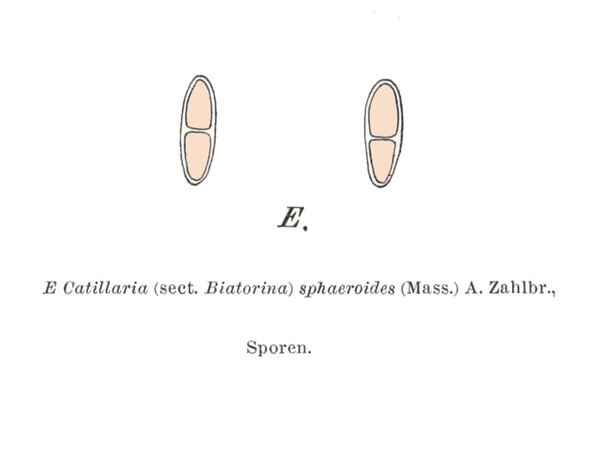Mycobilimbia sphaeroides (Dicks.) S. Ekman & Printzen
in Cannon & al., Revisions of British and Irish Lichens, 11: 76, 2021. Basionym: Lichen sphaeroides Dicks. - Fasc. Pl. Crypt. Brit., 1: 9, 1785
Synonyms: Bacidia sphaeroides (Dicks.) Zahlbr.; Biatora pilularis (Körb.) Hepp; Biatora sphaeroides (Dicks.) Hornem.; Biatorina pilularis Körb.; Biatorina sphaeroides A. Massal.; Bilimbia sphaeroides (Dicks.) Körb.; Catillaria sphaeroides (A. Massal.) Schuler non auct.; Mycobilimbia pilularis (Körb.) Hafellner & Türk
Distribution: N - VG, Frl, Ven, TAA (Nascimbene & al. 2007b, 2022, Nimis & al. 2015), Lomb, Piem (Isocrono & al. 2004), Lig (Giordani & al. 2025). C - Tosc, Umb (Ravera 1998, Panfili 2000b, Ravera & al. 2006), Laz (Ravera 2001, Nimis & Tretiach 2004), Abr (Gheza & al. 2021). S - Camp (Ravera & al. 2024a), Pugl, Cal (Puntillo 1995, 1996
Description: Thallus crustose, green to grey-green, thinly episubstratic, finely granulose, the granules 25-70 µm in diam., resembling soredia but corticate. Apothecia frequent, biatorine, round, sessile, 0.4-0.8(-1.2) mm across, with an initially flat but soon turning strongly convex, whitish, pale yellowish white or pale flesh-coloured disc (in old apothecia sometimes brown), the proper margin indistinct in mature apothecia, but conspicuous in young ones, smooth, paler than disc. Proper exciple well-developed, prosoplectenchymatous, of radiating, branched and anastomosing hyphae, colourless or pale yellow, 50-135 μm wide laterally; epithecium poorly differentiated, colourless to pale orange brown; hymenium colourless, 55-75 µm high; paraphyses mostly simple, coherent, 3-4 µm thick; subhymenium colourless, 50-85 μm high; hypothecium colourless, 100-250 μm high. Asci 8-spored, clavate, with a K/I+ blue apical dome penetrated by a narrow, K/I– apical cushion surrounded by a narrow, deeply K/I+ blue zone, the wall K/I- but surrounded by a I+ red-brown, K/I+ blue outer layer, the ocular chamber relatively small, Biatora-type. Ascospores (0-)1(-3)-septate (most ascospores 1-septate), hyaline, broadly ellipsoid to fusiform, (9-)12-17(-22) x (3-)4-5(-7) µm. Photobiont chlorococcoid. Spot tests, thallus and apothecia K-, C-, KC-, P-, UV-. Chemistry: without lichen substances. Note: on mosses growing on the bark of old deciduous trees, especially near the base of trunks in old, humid forests. Several old records are dubious, and could refer to Bilimbia sabuletorum.
Growth form: Crustose
Substrata: bark, soil, terricolous mosses, and plant debris
Photobiont: green algae other than Trentepohlia
Reproductive strategy: mainly sexual
Commonnes-rarity: (info)
Alpine belt: absent
Subalpine belt: absent
Oromediterranean belt: absent
Montane belt: rare
Submediterranean belt: extremely rare
Padanian area: absent
Humid submediterranean belt: very rare
Humid mediterranean belt: absent
Dry mediterranean belt: absent

Predictive model
Herbarium samples


P.L. Nimis; Owner: Department of Life Sciences, University of Trieste
Herbarium: TSB (30724)
2003/03/12


P.L. Nimis; Owner: Department of Life Sciences, University of Trieste
Herbarium: TSB (30724)
2003/03/12

Courtesy Danièle et Olivier Gonnet - Source: https://www.afl-lichenologie.fr/Photos_AFL/Photos_AFL_M/Texte_M2/Mycobilimbia_sphaeroides.htm
France, Saint-Jean-Lachalm, alt. 903 m - Haute-Loire - (43) - Forêt des Lombards, Corticole sur Fraxinus excelsior - leg. Arnaud Descheemacker
1/4/2017

Courtesy Danièle et Olivier Gonnet - Source: https://www.afl-lichenologie.fr/Photos_AFL/Photos_AFL_M/Texte_M2/Mycobilimbia_sphaeroides.htm
France, Saint-Jean-Lachalm, alt. 903 m - Haute-Loire - (43) - Forêt des Lombards, Corticole sur Fraxinus excelsior - leg. Arnaud Descheemacker
1/4/2017

Courtesy Danièle et Olivier Gonnet - Source: https://www.afl-lichenologie.fr/Photos_AFL/Photos_AFL_M/Texte_M2/Mycobilimbia_sphaeroides.htm
France, Saint-Jean-Lachalm, alt. 903 m - Haute-Loire - (43) - Forêt des Lombards, Corticole sur Fraxinus excelsior - leg. Arnaud Descheemacker
1/4/2017

Bernard Bouffinier - Source: http://www.lichensmaritimes.org/index.php?task=fiche&lichen=542&lang=en
France, Crozon

Bernard Bouffinier - Source: http://www.lichensmaritimes.org/index.php?task=fiche&lichen=542&lang=en
France, Crozon

Bernard Bouffinier - Source: http://www.lichensmaritimes.org/index.php?task=fiche&lichen=542&lang=en
France, Crozon

Bernard Bouffinier - Source: http://www.lichensmaritimes.org/index.php?task=fiche&lichen=542&lang=en
France, Crozon

Bernard Bouffinier - Source: http://www.lichensmaritimes.org/index.php?task=fiche&lichen=542&lang=en
France, Crozon

Bernard Bouffinier - Source: http://www.lichensmaritimes.org/index.php?task=fiche&lichen=542&lang=en
France, Crozon

Jacques Haine - Source: http://www.lichensmaritimes.org/index.php?task=fiche&lichen=542&lang=en
France, Signy-l'Abbaye

Jacques Haine - Source: http://www.lichensmaritimes.org/index.php?task=fiche&lichen=542&lang=en
France, Signy-l'Abbaye

Jacques Haine - Source: http://www.lichensmaritimes.org/index.php?task=fiche&lichen=542&lang=en
France, Signy-l'Abbaye

Jacques Haine - Source: http://www.lichensmaritimes.org/index.php?task=fiche&lichen=542&lang=en
France, Crozon

Jacques Haine - Source: http://www.lichensmaritimes.org/index.php?task=fiche&lichen=542&lang=en
France, Crozon

Jacques Haine - Source: http://www.lichensmaritimes.org/index.php?task=fiche&lichen=542&lang=en
France, Crozon

Jacques Haine - Source: http://www.lichensmaritimes.org/index.php?task=fiche&lichen=542&lang=en
France, Crozon

Jacques Haine - Source: http://www.lichensmaritimes.org/index.php?task=fiche&lichen=542&lang=en
France, Crozon

Jacques Haine - Source: http://www.lichensmaritimes.org/index.php?task=fiche&lichen=542&lang=en
France, Crozon

Jacques Haine - Source: http://www.lichensmaritimes.org/index.php?task=fiche&lichen=542&lang=en
France, Crozon

Jacques Haine - Source: http://www.lichensmaritimes.org/index.php?task=fiche&lichen=542&lang=en
France, Crozon

Jacques Haine - Source: http://www.lichensmaritimes.org/index.php?task=fiche&lichen=542&lang=en
France, Crozon
Growth form: Crustose
Substrata: bark, soil, terricolous mosses, and plant debris
Photobiont: green algae other than Trentepohlia
Reproductive strategy: mainly sexual
Commonnes-rarity: (info)
Alpine belt: absent
Subalpine belt: absent
Oromediterranean belt: absent
Montane belt: rare
Submediterranean belt: extremely rare
Padanian area: absent
Humid submediterranean belt: very rare
Humid mediterranean belt: absent
Dry mediterranean belt: absent

Predictive model
| Herbarium samples |


P.L. Nimis; Owner: Department of Life Sciences, University of Trieste
Herbarium: TSB (30724)
2003/03/12


P.L. Nimis; Owner: Department of Life Sciences, University of Trieste
Herbarium: TSB (30724)
2003/03/12

Courtesy Danièle et Olivier Gonnet - Source: https://www.afl-lichenologie.fr/Photos_AFL/Photos_AFL_M/Texte_M2/Mycobilimbia_sphaeroides.htm
France, Saint-Jean-Lachalm, alt. 903 m - Haute-Loire - (43) - Forêt des Lombards, Corticole sur Fraxinus excelsior - leg. Arnaud Descheemacker
1/4/2017

Courtesy Danièle et Olivier Gonnet - Source: https://www.afl-lichenologie.fr/Photos_AFL/Photos_AFL_M/Texte_M2/Mycobilimbia_sphaeroides.htm
France, Saint-Jean-Lachalm, alt. 903 m - Haute-Loire - (43) - Forêt des Lombards, Corticole sur Fraxinus excelsior - leg. Arnaud Descheemacker
1/4/2017

Courtesy Danièle et Olivier Gonnet - Source: https://www.afl-lichenologie.fr/Photos_AFL/Photos_AFL_M/Texte_M2/Mycobilimbia_sphaeroides.htm
France, Saint-Jean-Lachalm, alt. 903 m - Haute-Loire - (43) - Forêt des Lombards, Corticole sur Fraxinus excelsior - leg. Arnaud Descheemacker
1/4/2017

Bernard Bouffinier - Source: http://www.lichensmaritimes.org/index.php?task=fiche&lichen=542&lang=en
France, Crozon

Bernard Bouffinier - Source: http://www.lichensmaritimes.org/index.php?task=fiche&lichen=542&lang=en
France, Crozon

Bernard Bouffinier - Source: http://www.lichensmaritimes.org/index.php?task=fiche&lichen=542&lang=en
France, Crozon

Bernard Bouffinier - Source: http://www.lichensmaritimes.org/index.php?task=fiche&lichen=542&lang=en
France, Crozon

Bernard Bouffinier - Source: http://www.lichensmaritimes.org/index.php?task=fiche&lichen=542&lang=en
France, Crozon

Bernard Bouffinier - Source: http://www.lichensmaritimes.org/index.php?task=fiche&lichen=542&lang=en
France, Crozon

Jacques Haine - Source: http://www.lichensmaritimes.org/index.php?task=fiche&lichen=542&lang=en
France, Signy-l'Abbaye

Jacques Haine - Source: http://www.lichensmaritimes.org/index.php?task=fiche&lichen=542&lang=en
France, Signy-l'Abbaye

Jacques Haine - Source: http://www.lichensmaritimes.org/index.php?task=fiche&lichen=542&lang=en
France, Signy-l'Abbaye

Jacques Haine - Source: http://www.lichensmaritimes.org/index.php?task=fiche&lichen=542&lang=en
France, Crozon

Jacques Haine - Source: http://www.lichensmaritimes.org/index.php?task=fiche&lichen=542&lang=en
France, Crozon

Jacques Haine - Source: http://www.lichensmaritimes.org/index.php?task=fiche&lichen=542&lang=en
France, Crozon

Jacques Haine - Source: http://www.lichensmaritimes.org/index.php?task=fiche&lichen=542&lang=en
France, Crozon

Jacques Haine - Source: http://www.lichensmaritimes.org/index.php?task=fiche&lichen=542&lang=en
France, Crozon

Jacques Haine - Source: http://www.lichensmaritimes.org/index.php?task=fiche&lichen=542&lang=en
France, Crozon

Jacques Haine - Source: http://www.lichensmaritimes.org/index.php?task=fiche&lichen=542&lang=en
France, Crozon

Jacques Haine - Source: http://www.lichensmaritimes.org/index.php?task=fiche&lichen=542&lang=en
France, Crozon

 INDEX FUNGORUM
INDEX FUNGORUM
 GBIF
GBIF
 DOLICHENS
DOLICHENS









